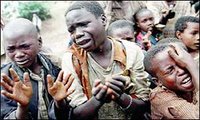 Torn by ethnic conflict between the Tutsis and the Hutus, Rwanda experienced Africa's worst genocide in modern times. The conflict had origins in Belgium's colonial rule, which favored the minority Tutsis and fostered differences between the two groups. In 1962, when the country gained independence, Gregoire Kayibanda headed the first recognized Hutu government. Juvenal Habyarimana seized power in a military coup a decade later, following the massacre of thousands of Hutus in neighboring Burundi. For nearly twenty years under Habyarimana, ethnic relations simmered with sporadic outbreaks of violence. In 1993, Habyarimana signed a short-lived power-sharing agreement with the Tutsis, aiming to end the fighting. In April 1994, the plane carrying Habyarimana
Torn by ethnic conflict between the Tutsis and the Hutus, Rwanda experienced Africa's worst genocide in modern times. The conflict had origins in Belgium's colonial rule, which favored the minority Tutsis and fostered differences between the two groups. In 1962, when the country gained independence, Gregoire Kayibanda headed the first recognized Hutu government. Juvenal Habyarimana seized power in a military coup a decade later, following the massacre of thousands of Hutus in neighboring Burundi. For nearly twenty years under Habyarimana, ethnic relations simmered with sporadic outbreaks of violence. In 1993, Habyarimana signed a short-lived power-sharing agreement with the Tutsis, aiming to end the fighting. In April 1994, the plane carrying Habyarimana and the President of Burundi was shot down. The event triggered the notorious genocide. Extremist Hutu militia aided by the Rwandan army launched systematic massacres against Tutsis. Despite reports of mass killings, the UN failed to take immediate action to stop the massacres, due to opposition from France and the US. Around 800,000 Tutsis and moderate Hutus were killed within 100 days, and over three million people fled to neighboring countries. In the years following the genocide, the Rwanda Patriotic Front (RPF) established a Government of National Unity, seeking reconciliation between the two ethnic groups. In 1995, a UN-appointed International Criminal Tribunal for Rwanda (ICTR) began trying those responsible for the 1994 atrocities. However, Rwanda's efforts at recovery have been marred by its involvement in the conflict in Democratic Republic of Congo.
and the President of Burundi was shot down. The event triggered the notorious genocide. Extremist Hutu militia aided by the Rwandan army launched systematic massacres against Tutsis. Despite reports of mass killings, the UN failed to take immediate action to stop the massacres, due to opposition from France and the US. Around 800,000 Tutsis and moderate Hutus were killed within 100 days, and over three million people fled to neighboring countries. In the years following the genocide, the Rwanda Patriotic Front (RPF) established a Government of National Unity, seeking reconciliation between the two ethnic groups. In 1995, a UN-appointed International Criminal Tribunal for Rwanda (ICTR) began trying those responsible for the 1994 atrocities. However, Rwanda's efforts at recovery have been marred by its involvement in the conflict in Democratic Republic of Congo.

All this information is collected from web-pages about Rwanda. Some of the dates could be aproximated and not exact.
 Torn by ethnic conflict between the Tutsis and the Hutus,
Torn by ethnic conflict between the Tutsis and the Hutus,  and the President of
and the President of  Torn by ethnic conflict between the Tutsis and the Hutus,
Torn by ethnic conflict between the Tutsis and the Hutus,  and the President of
and the President of 

No hay comentarios:
Publicar un comentario